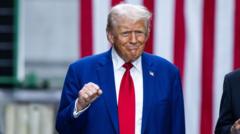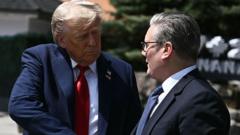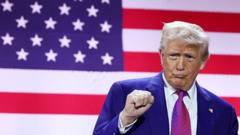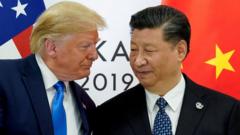Donald Trump's recent economic promises include tackling inflation, imposing tariffs, and reducing taxes, aimed at stimulating a struggling economy. However, experts caution that the conflicting nature of these goals, alongside external economic factors, cast doubt on their feasibility.
Promises vs. Reality: Trump's Economic Vision Under Scrutiny

Promises vs. Reality: Trump's Economic Vision Under Scrutiny
As Trump outlines ambitious economic reforms, analysts warn that contradictions in his policies may undermine his commitments.
Donald Trump is once again at the forefront of economic discourse, as he proposes a series of sweeping changes aimed at revitalizing the U.S. economy and restoring faith in the American dream. From the stage of Mar-a-Lago, he highlighted an "end to the devastating inflation crisis," promising significant tax cuts, reduced regulations, and a smaller government. This ambitious vision, he insists, will usher in a new era of prosperity, declaring, "We are at the beginning of a great, beautiful golden age of business."
However, as Trump prepares to implement his plans, mounting concerns loom over the economic landscape. Analysts warn that many of his strategies could potentially harm the economy rather than help it. Romina Boccia, an economist at the Cato Institute, emphasized that the inherent contradictions in Trump's agenda complicate the pathway to achieving his goals. "There's no clear path forward at this time for how to meet all these goals," she stated.
Among Trump's prominent promises is tackling inflation, a goal he claims will lead to lower prices for Americans. Yet, experts point out that significant drops in prices are rare except during economic turmoil. While inflation rates have decreased recently, they remain challenging to control. Trump's strategies may involve expanding U.S. oil and gas production to alleviate energy costs; however, many factors influencing inflation are beyond presidential authority.
Additionally, Trump’s controversial proposal to impose blanket tariffs has raised eyebrows. He has suggested imposing a minimum 10% tariff on all imports and a staggering 60% on Chinese goods. As speculation mounts regarding the extent of these tariffs and their impact, analysts caution that imposing such measures could lead to higher costs for consumers and potential backlash from trading partners.
Another cornerstone of Trump's economic agenda revolves around tax cuts and curtailing government spending. He argues that lowering taxes and reducing regulation will unleash American enterprise. Nonetheless, experts warn that the push for reduced regulation may face hurdles, while the extension of tax cuts could exacerbate existing high levels of U.S. debt. The broader fiscal implications of these policies are concerning, as projected debts could surpass $4.5 trillion in the coming decade.
Amid the complexities of economic reform, Trump supporters have offered diverse views. Some express faith in their leader's ability to negotiate better deals, highlighting his reputation as a skilled deal-maker. Yet, others acknowledge the necessity of strategic decisions, especially concerning tariffs and manufacturing resurgence in an evolving global landscape.
While Trump's enthusiastic visions for the economy resonate with many voters, the tangible execution of these grand promises remains uncertain. As he embarks on this new chapter, the interplay of ambitious goals, external pressures, and political realities will undoubtedly shape the conclusions of his economic agenda.




















